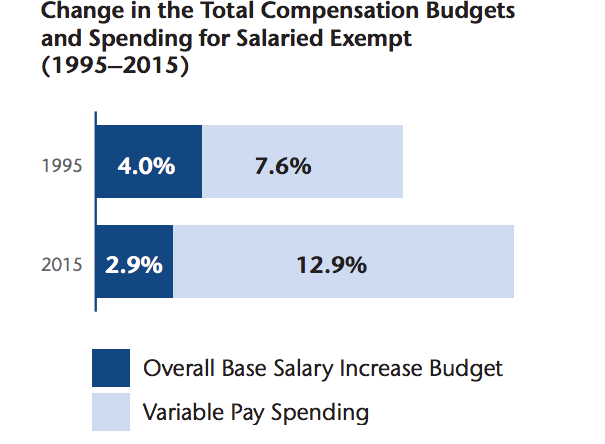When it comes to salary, your employer no longer wants to marry you. He's more looking to date and see how it goes.
Right now, it's going pretty well. Businesses in the U.S. set aside a record amount of their budgets to give workers more money, according to report out Wednesday.
The trouble is, most of this money is for one-off bonuses, not long-term salary increases.
U.S. companies allocated a record 15.8 percent of their budgets for pay increases this year, according to a survey of 1,214 businesses conducted by Aon Hewitt, a human resource consultancy. That's a slight bump from last year's 15.6 percent.
The bummer is that companies only devoted 2.9 percent of that for actual salary increases -- the same amount as last year. Bonuses and one-off cash compensation make up the rest.
For top earners, this is great news -- fat bonuses for everyone! For middle-income salaried workers, this is a mixed blessing; they'll get lots more money for now, but who knows for how long. Oh, and hourly workers? They mostly miss out.
The move to so-called "variable" pay -- the short-term dating model of income -- is a trend that's been decades in the making. With lower fixed pay raises and higher variable pay, employers can reward top performers without committing to a long-term thing. If the company doesn’t do so well the following year, or if you don’t bring your A-game, you make less money.
Back in 1995, the average raise was 4 percent, and companies set aside 7.6 percent for variable compensation. While the overall pie has gotten much bigger in the intervening decades, alas, not all of us get a slice.

The New York Times wrote a big piece about this a few months ago after looking at Aon’s 2014 report on pay, which showed a similar trend. It’s yet another sign of rising income inequality in the United States -- those in already well-paying jobs are enjoying record-high pay increases. At the highest end, CEO pay has skyrocketed.
For everyone else, things are pretty meh.
While a full 93 percent of companies now offer these one-off pay perks, or variable pay, only half of all hourly workers receive them, Ken Abosch, a partner at Aon Hewitt, told The Huffington Post.
“[Hourly workers] are basically at the mercy of the salary increase, and they don’t have the opportunity for bonuses,” he said. Such workers include machine operators, drivers, low-paid analysts and administrative assistants. Also, workers in the nonprofit sector are much less likely to get variable pay.
And -- though this should surprise absolutely no one -- bonuses tend to be lots higher for those at the top of the company food chain. “So the person sweeping the floor gets a 5 percent bonus, whereas the CEO is eligible for 50 or 75 percent of their salary,” Abosch said.
C-suite executives have always been paid like this. What’s new is that now, more and more employees well below the senior level are subject to variable pay. It creates a lot more uncertainty for middle-class workers.
“In years where the company outperforms, you’ll do well. In the lean years, you’re not going to receive as much,” Abosch said. “It’s something that’s been available to executives and has become much more commonplace for broad-based employees.”
Of course, pay has never been equal in business, and most people really don't think it should be. “I don’t think anybody knows just how unequal is the right unequal, but there’s no doubt it’s becoming more unequal,” said Barry Gerhart, the Bruce R. Ellig Distinguished Chair in Pay and Organizational Effectiveness at the University of Wisconsin-Madison, who has written a book on compensation.
Gerhart said that companies are moving away from salary increases so they can keep their fixed costs down. In other words, if you commit to giving a worker a raise, you’re locked in to a big budget increase in the years ahead. With a one-off bump, there’s less of a permanent strain on your budget.
Employers' move toward variable pay and away from salary increases is similar to their move away from providing pensions or health care to retirees. Corporations who want to stay competitive don’t want to be burdened by “things that you award and are with you forever,” Gerhart said.
For this year’s study, Aon asked businesses in July about their 2015 budgets and projections for next year. The survey covered 728 service organizations (think PricewaterhouseCoopers), 469 manufacturers and 17 multi-industry organizations (think Berkshire Hathaway).
The companies that Aon surveyed tended to pay slightly better than the typical U.S. company, Gerhart said. The lowest annual base salary of a worker eligible for variable pay was $37,682, according to Aon.
